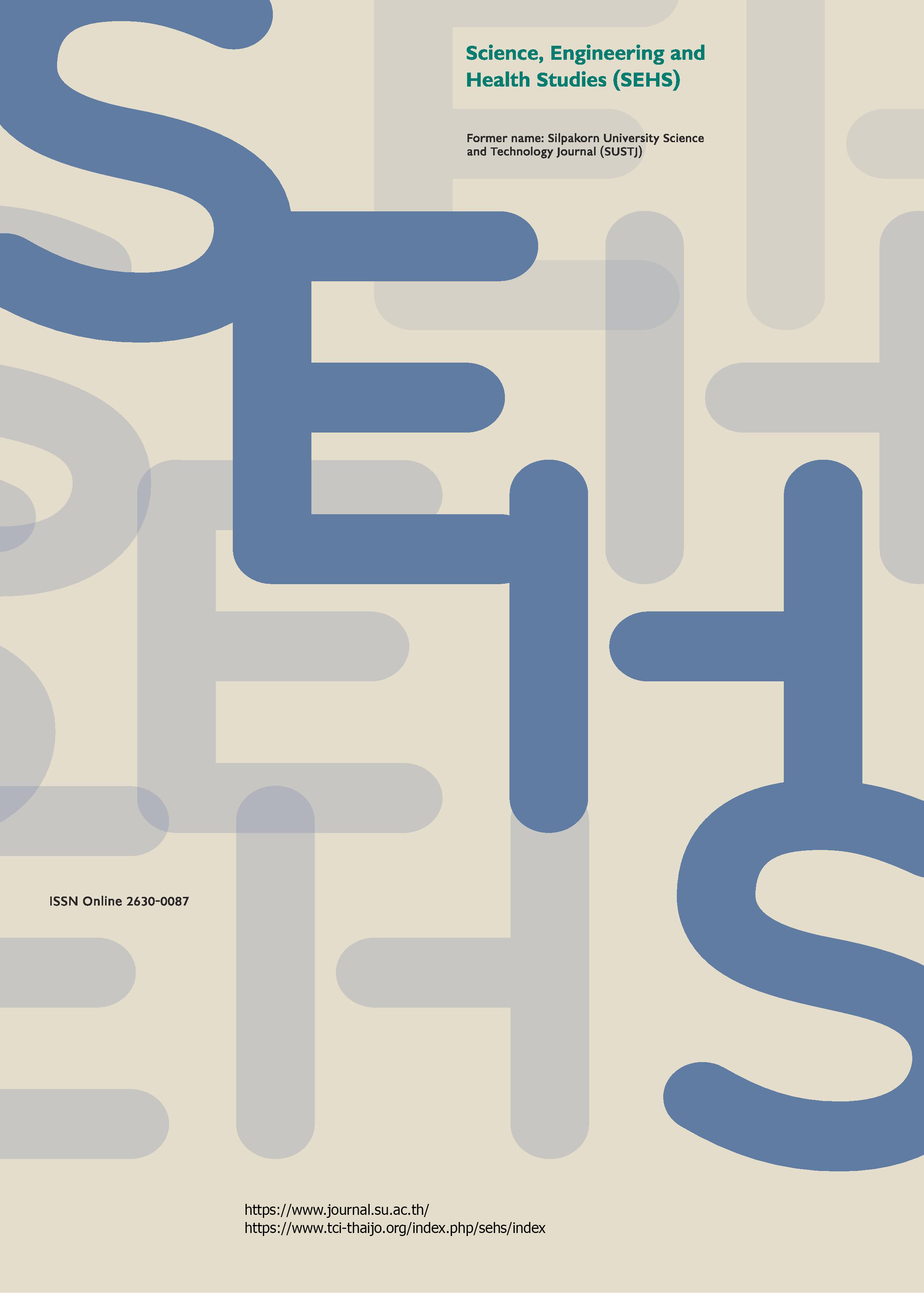Improved ultra-short-term pulse rate variability using hair detection and majority vote in subintervals
Main Article Content
Abstract
Remote photoplethysmography (rPPG) is a non-contact method for extracting pulse signal from a region of interest (ROI) in a human facial video. This technique enables researchers to remotely measure both heart rate and pulse rate variability (PRV). However, when the forehead is used as the ROI for rPPG signal extraction, hair can obscure parts of the skin, and changes in ambient lighting may introduce spurious frequency spikes, which degrade the rPPG signal and PRV accuracy. This paper proposed a method to improve ultra-short-term PRV derived from the rPPG signal using the forehead ROI. The approach incorporated a hair detection algorithm to extract the rPPG signal from skin areas, excluding regions covered by hair. In addition, a majority voting mechanism was applied to subintervals to determine the optimal passband frequency for a bandpass filter, effectively eliminating spurious frequencies. The ultra-short-term PRV was then computed from the refined rPPG signal. Results show that the mean absolute error of the ultra-short-term PRV was improved for most subjects compared to the mean absolute error obtained via the conventional method.
Downloads
Article Details

This work is licensed under a Creative Commons Attribution-NonCommercial-NoDerivatives 4.0 International License.
References
Aimie-Salleh, N., Ghani, N. A. A., Hasanudin, N., and Shafie, S. N. S. (2020). Heart rate variability recording system using photoplethysmography sensor. In Autonomic Nervous System Monitoring - Heart Rate Variability (Aslanidis, T., Ed.), pp. 29–44. London: IntechOpen.
Bobbia, S., Macwan, R., Benezeth, Y., Mansouri, A., and Dubois, J. (2019). Unsupervised skin tissue segmentation for remote photoplethysmography. Pattern Recognition Letters, 124, 82–90.
Bolanos, M., Nazeran, H., and Haltiwanger, E. (2006). Comparison of heart rate variability signal features derived from electrocardiography and photoplethysmography in healthy individuals. In Proceedings of the 28th Annual International Conference of the IEEE Engineering in Medicine and Biology Society, pp. 4289–4294. New York, USA.
de Haan, G., and Jeanne, V. (2013). Robust pulse rate from chrominance-based rPPG. IEEE Transactions on Biomedical Engineering, 60(10), 2878–2886.
Finžgar, M., and Podržaj, P. (2020). Feasibility of assessing ultra-short-term pulse rate variability from video recordings. PeerJ, 8, e8342.
Gudi, A., Bittner, M., and van Gemert, J. (2020). Real-time webcam heart-rate and variability estimation with clean ground truth for evaluation. Applied Sciences, 10(23), 8630.
Kartynnik, Y., Ablavatski, A., Grishchenko, I., and Grundmann, M. (2019). Real-time facial surface geometry from monocular video on mobile GPUs. CVPR Workshop on Computer Vision for Augmented and Virtual Reality 2019, Long Beach, CA, USA. [Online URL: https://arxiv.org/pdf/1907.06724v1] accessed on September 29, 2023.
Kumar, M., Veeraraghavan, A., and Sabharwal, A. (2015). DistancePPG: Robust non-contact vital signs monitoring using a camera. Biomedical Optics Express, 6(5), 1565–1588.
Lewandowska, M., Rumiński, J., Kocejko, T., and Nowak, J. (2011). Measuring pulse rate with a webcam — A non-contact method for evaluating cardiac activity. In Proceedings of the 2011 Federated Conference on Computer Science and Information Systems, pp. 405–410. Szczecin, Poland.
Makowski, D., Pham, T., Lau, Z. J., Brammer, J. C., Lespinasse, F., Pham, H., Schölzel, C., and Chen, S. H. A. (2021). NeuroKit2: A python toolbox for neurophysiological signal processing. Behavior Research Methods, 53(4), 1689–1696.
McCraty, R., and Shaffer, F. (2015). Heart rate variability: New perspectives on physiological mechanisms, assessment of self-regulatory capacity, and health risk. Global Advances in Health and Medicine, 4(1), 46–61.
Panigrahi, A., and Sharma, H. (2022). Non-contact HR extraction from different color spaces using RGB camera. In Proceedings of the 2022 National Conference on Communications (NCC), pp. 332–337. Mumbai, India.
Peng, R.-C., Zhou, X.-L., Lin, W.-H., and Zhang, Y.-T. (2015). Extraction of heart rate variability from smartphone photoplethysmograms. Computational and Mathematical Methods in Medicine, 2015(1), 516826.
Pinheiro, N., Couceiro, R., Henriques, J., Muehlsteff, J., Quintal, I., Gonçalves, L., and Carvalho, P. (2016). Can PPG be used for HRV analysis? In Proceedings of the 38th Annual International Conference of the IEEE Engineering in Medicine and Biology Society (EMBC), pp. 2945–2949. Orlando, FL, USA.
Poh, M.-Z., McDuff, D. J., and Picard, R. W. (2010). Non-contact, automated cardiac pulse measurements using video imaging and blind source separation. Optics Express, 18(10), 10762–10774.
Pourbemany, J., Almabrok, E., and Zhu, Ye. (2021). Real-time video-based heart and respiration rate monitoring. In Proceedings of NAECON 2021 - IEEE National Aerospace and Electronics Conference, pp. 332–336. Dayton, OH, USA.
Ryu, J., Hong, S., Liang, S., Pak, S., Chen, Q., and Yan, S. (2021). Research on the combination of color channels in heart rate measurement based on photoplethysmography imaging. Journal of Biomedical Optics, 26(2), 025003.
Sanyal, S., and Nundy, K. K. (2018). Algorithms for monitoring heart rate and respiratory rate from the video of a user's face. IEEE Journal of Translational Engineering in Health and Medicine, 6, 2700111.
Sunkom, P., Worasawate, D., Srisurangkul, C., and Nakayama, M. (2023). Improved heart rate estimation from facial videos using hair detection and majority vote in subintervals. In Proceedings of the 20th International Joint Conference on Computer Science and Software Engineering (JCSSE), pp. 380–384. Phitsanulok, Thailand.
Vescio, B., Salsone, M., Gambardella, A., and Quattrone, A. (2018). Comparison between electrocardiographic and earlobe pulse photoplethysmographic detection for evaluating heart rate variability in healthy subjects in short- and long-term recordings. Sensors, 18(3), 844.
Wang, W., den Brinker, A. C., Stuijk, S., and de Haan, G. (2017). Algorithmic principles of remote PPG. IEEE Transactions on Biomedical Engineering, 64(7), 1479–1491.
Yu, S.-G., Kim, S.-E., Kim, N. H., Suh, K. H., and Lee, E. C. (2021). Pulse rate variability analysis using remote photoplethysmography signals. Sensors, 21(18), 6241.

